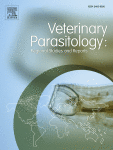Ver ítem
- xmlui.general.dspace_homeCentros e Institutos de InvestigaciónCIPAF. Centro de Investigación y Desarrollo Tecnológico para la Agricultura FamiliarIPAF NOAArtículos científicosxmlui.ArtifactBrowser.ItemViewer.trail
- Inicio
- Centros e Institutos de Investigación
- CIPAF. Centro de Investigación y Desarrollo Tecnológico para la Agricultura Familiar
- IPAF NOA
- Artículos científicos
- Ver ítem
Seropositivity to Sarcocystis infection of llamas correlates with breeding practices
Resumen
Production of llama (Lama glama) meat in rural communities of the Andean regions is largely affected by Sarcocystis spp. infection. Macroscopic cysts develop in muscles as a consequence of S. aucheniae parasitism, often resulting in meat downgrade or condemnation. Llama meat production is informal in Argentina but has broad perspectives for improvement, and would significantly benefit from the development of standardized control methodologies. This work
[ver mas...]
Production of llama (Lama glama) meat in rural communities of the Andean regions is largely affected by Sarcocystis spp. infection. Macroscopic cysts develop in muscles as a consequence of S. aucheniae parasitism, often resulting in meat downgrade or condemnation. Llama meat production is informal in Argentina but has broad perspectives for improvement, and would significantly benefit from the development of standardized control methodologies. This work analyzes whether the presence of anti-Sarcocystis spp. antibodies in llamas is influenced by factors such as geographic region and/or herd management practices. To this aim, an indirect ELISA was set up based on a ~ 23 kDa soluble immunogenic protein fraction (Sa23), isolated from S. aucheniae macrocysts (Sa23-iELISA). Serum samples (n = 507) were collected from llamas bred under three different conditions: (i) with no sanitation controls and in the presence of pastoral dogs by small producers of different localities of the Argentine Puna (Group I, n = 237); (ii) with sanitation controls and no pastoral dogs, in fenced fields of an experimental agricultural station in the Argentine Puna (Group II, n = 167); and (iii) with sanitation controls and no pastoral dogs in fenced fields of farms of the humid Pampas (Group III, n = 103). Results of the Sa23-iELISA were expressed as percentages of positivity with respect to a reference Sarcocystis-positive serum. Notably, the percentage of sera that fell above the cut-off (31.5% positivity) in group (i) was significantly higher (p < 0.001) than those of groups (ii) and (iii) (50% vs 23% and 26%, respectively). These results indicate that herd management practices constitute a critical risk factor for sarcocystiosis in llamas. Differences in these practices include feeding of dogs with raw Sarcocystis-infected llama meat, with the consequent maintenance of the parasite life cycle by the contamination of pastures and water with fecal-derived infective oocysts/sporocysts. Additionally, the itinerancy of llama herds in search for pastures and water sources possibly exposes animals to a higher number of infective foci. On the other hand, percentages of seropositive llamas kept under controlled conditions in the Puna or the humid Pampas were not significantly different, suggesting that climate, altitude, and/or pasture characteristics do not influence Sarcocystis-infection. Male gender and older age of llamas were found to be propensity factors for sarcocystiosis in llamas bred in La Puna under controlled conditions. Availability of diagnostic tools, as well as increased knowledge on the parasite and its epidemiology, will allow the design of control strategies for SAC sarcocystiosis.
[Cerrar]

Autor
Romero, Sandra Raquel;
Carletti, Tamara;
Decker Franco, Cecilia;
Moré, Gastón;
Schnittger, Leonhard;
Florin-Christensen, Mónica;
Fuente
Veterinary parasitology: regional studies and reports 10 : 65-70. (December 2017)
Fecha
2017-12
ISSN
2405-9390
Formato
pdf
Tipo de documento
artículo
Palabras Claves
Derechos de acceso
Restringido
 Excepto donde se diga explicitamente, este item se publica bajo la siguiente descripción: Creative Commons Attribution-NonCommercial-ShareAlike 2.5 Unported (CC BY-NC-SA 2.5)
Excepto donde se diga explicitamente, este item se publica bajo la siguiente descripción: Creative Commons Attribution-NonCommercial-ShareAlike 2.5 Unported (CC BY-NC-SA 2.5)

